Building an attack from the back
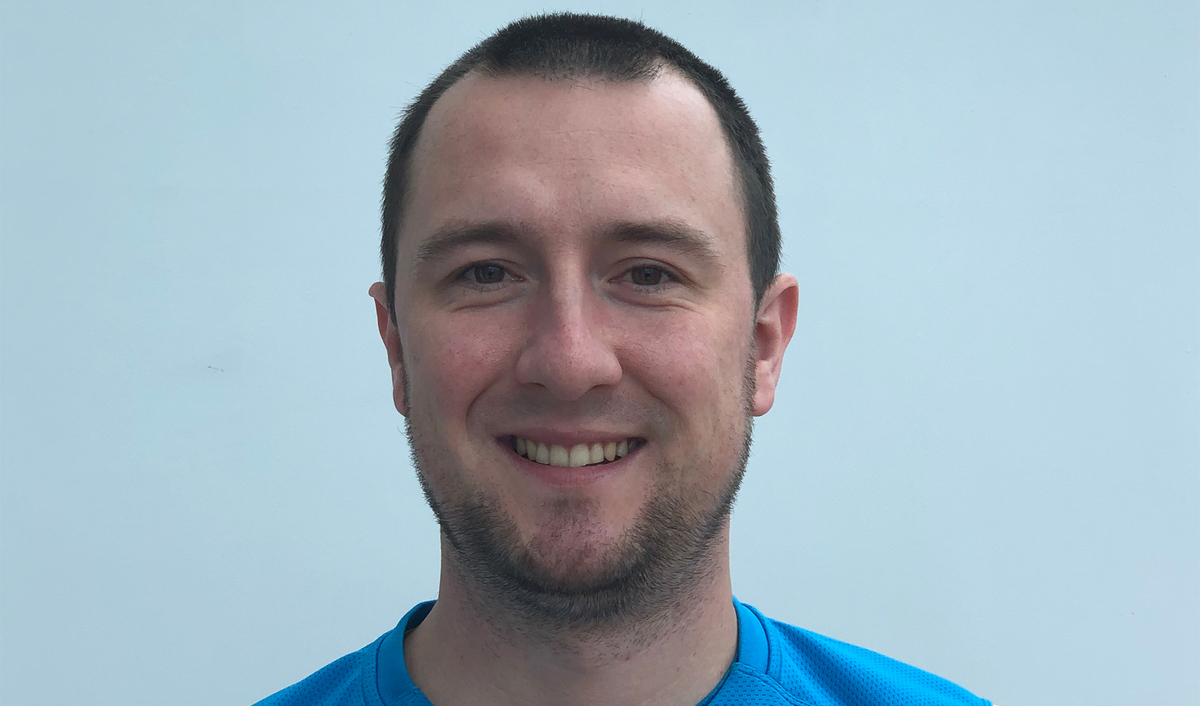
| Area | Half a pitch |
| Equipment | Balls, bibs, cones, 2 small goals, 1 full-size goal |
| No. of Players | Up to 11 players + 1 goalkeeper |
| Session Time | Wave Practice: 25-40mins in blocks of 8mins |
This session is all about building the attack from the goalkeeper and breaking through a high press. In this activity we see the goalkeeper as an extra player and we encourage centre backs to receive the ball and play forwards.
It’s a game-based practice that encourages lots of decision making under pressure. It’s a competitive activity that allows for lots of repetition and it also encourages dual coaching opportunities: one coach can work on building the attack whilst the other coach works on either the finishing or the high press.
This practice is flexible enough to accommodate a change in playing numbers or playing formations, again allowing the coach to create scenarios and challenges for players that can help with both individual and group learning.
As the session is designed to be game-realistic, players really enjoy it. The activity is competitive and as it offers plenty of repetitions of match scenarios, it can therefore be used as a match preparation session or an individual player development session.
Distances can increase or decrease to help with physical loading, especially with the high number of transitions involved.
WAVE PRACTICE
We set up a playing area on one half of the pitch, coned off to a width of 40 yards. We position a goal and a goalkeeper at one end and two small goals at the other end. The size of the playing area can vary, but typically we would use the geography of the pitch to create a 60x40-yard area.
We’re using nine outfield players, split into: a blue team of three who are attacking the small goals; two yellow wide players who are positioned on each side of the playing area; and four reds, only two of whom are in play at any one time. The extra red pair wait between the small goals ready to rotate in.
The goalkeeper passes out to the blue team of three, who are made up of two centre backs and a defensive midfielder. They must build an attack from the back using the full width of the playing area and they can score by passing into one of the small goals, as shown [1a]. The red pair are forwards trying to stop the attack and they should press high in the blue team’s defensive third. If the reds win possession, they should counter-attack the main goal.
1a
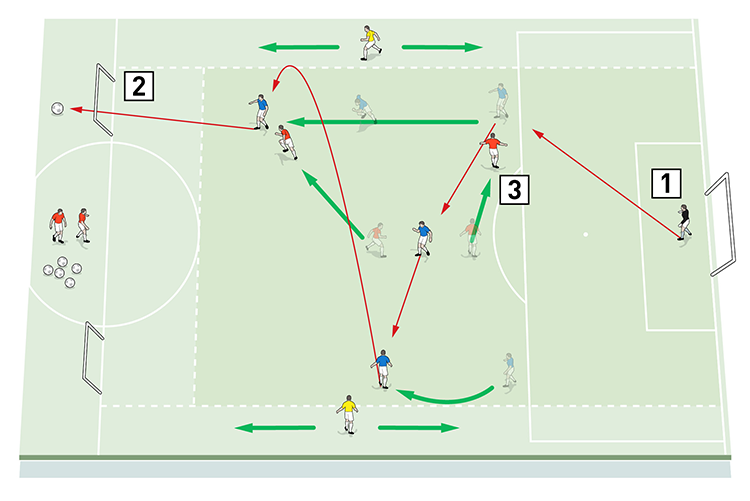
2. The blues can score by passing into one of the small goals
3. The red pair press high in the blue team’s defensive third. If they win possession, they should counter-attack the main goal
If the blues score in one of the small goals, or if the ball goes dead, one of the waiting reds acts as a server and passes in to the active red pair so they can counter-attack and try to score past the keeper in the main goal. They can do so with the help of the unopposed yellow wide players on the outside edge of the playing area, as shown [1b].
1b
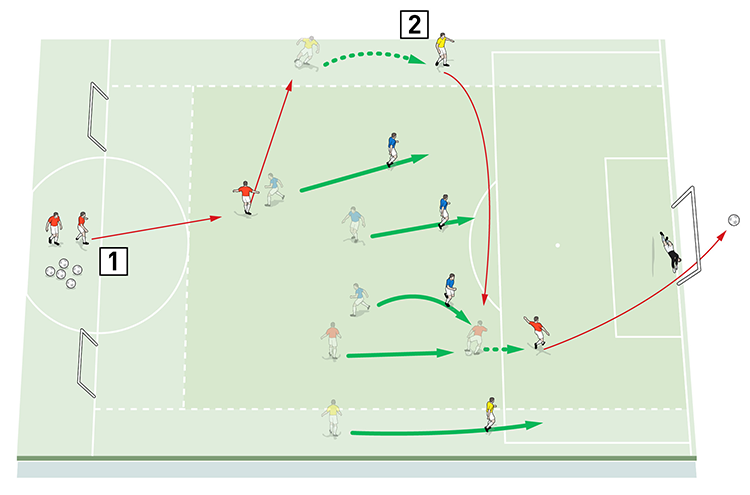
2. The red pair attack with the help of the unopposed yellow wide players
WAVE PRACTICE PROGRESSIONS
We use the same set-up but we progress the activity so there are offsides for the wide players. The blues still build their attack from the back as before, but if the red pair wins possession we now allow one of the red servers to step in to join the attack with the red pressing pair and the two yellow wide players, as shown [2a]. This gives the counter-attacking team a 5v3 overload on transition.
2a
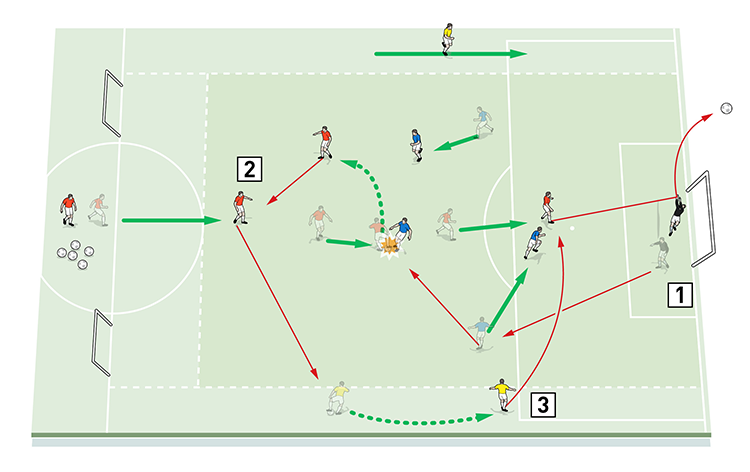
2. If the pressing red pair wins possession, progress the activity so one of the servers can step in to support the counter-attack
3. Progress further by introducing offsides for the yellow wide players
We can progress the activity further by adding a pair of waiting blues between the small goal; if the reds gain possession one of the waiting blues can make a defensive recovery run to try to help his team mates prevent the counter-attacking reds from scoring, as shown [2b].
2b
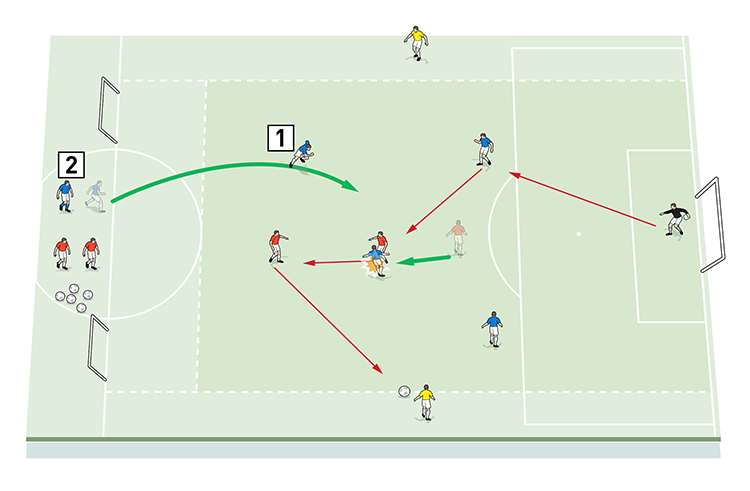
2. If the reds gain possession, one of the waiting blues can now make a recovery run to help his team mates defend
The session can be progressed further by introducing scoring systems. For example, when working on building the attack against a high press, if the blues score into the mini goals we allow them to restart play from the goalkeeper and if they maintain possession for six seconds then their goal stands. However, if the red pressing team wins the ball back within six seconds and scores in the main goal, the red goal is worth double and the blue goal no longer counts, as shown [2c].
2c
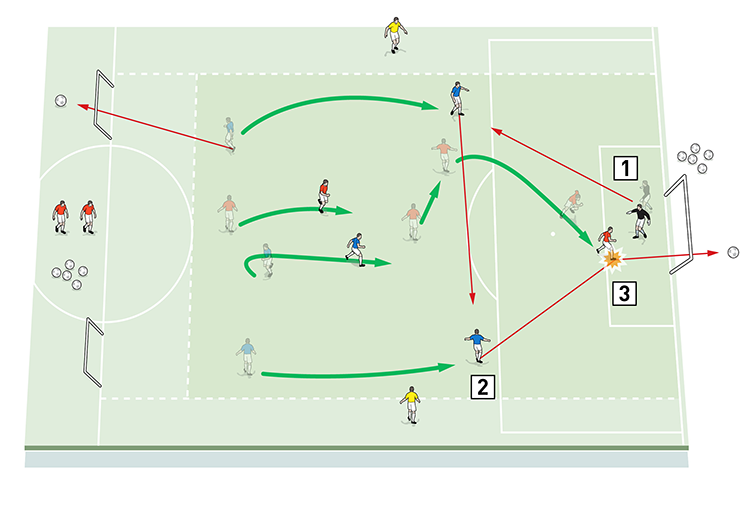
2. If the blues maintain possession for six seconds from the keeper’s pass out, then their goal stands
3. If the reds win the ball back within six seconds and score, their goal is worth double and the blue goal no longer counts
COACHING POINTS
What are the key things to look for?
Technically, we want to see players adopting the correct body shape to receive and to play forwards. The detail of the pass should also be correct: to the back foot, neat to feet with an ideal pace on the pass to allow the receiver to play forwards quickly.
Tactically, we want to see the build-up of play from the back using the goalkeeper to support. The starting positions are key to allowing the attack to progress and the distance of the centre backs in relation to both the ball and the opponent is vital. Midfield rotation is also important, as is recognising the opposition set-up to avoid playing into traps.
What are the typical mistakes players might make and how do I avoid them?
Players often don’t recognise how the opponent is set up and in academy football the centre backs always drop to receive instead of recognising how high they can build from, perhaps if the opponent is not ready and not in a position to press. Players also tend to play the first pass they see as opposed to building from as high as possible.
Editor's Picks
Attacking transitions
Deep runs in the final third
Using the goalkeeper in build-up play
Intensive boxes drill with goals
Penetrating the final third
Creating and finishing
My philosophy
Pressing initiation
Compact team movement
Coaches' Testimonials

Alan Pardew

Arsène Wenger

Brendan Rodgers

Carlos Carvalhal

José Mourinho

Jürgen Klopp

Pep Guardiola

Roy Hodgson

Sir Alex Ferguson

Steven Gerrard
Coaches' Testimonials

Gerald Kearney, Downtown Las Vegas Soccer Club

Paul Butler, Florida, USA

Rick Shields, Springboro, USA

Tony Green, Pierrefonds Titans, Quebec, Canada
Join the world's leading coaches and managers and discover for yourself one of the best kept secrets in coaching. No other training tool on the planet is written or read by the calibre of names you’ll find in Elite Soccer.
In a recent survey 92% of subscribers said Elite Soccer makes them more confident, 89% said it makes them a more effective coach and 91% said it makes them more inspired.
Get Monthly Inspiration
All the latest techniques and approaches
Since 2010 Elite Soccer has given subscribers exclusive insight into the training ground practices of the world’s best coaches. Published in partnership with the League Managers Association we have unparalleled access to the leading lights in the English leagues, as well as a host of international managers.
Elite Soccer exclusively features sessions written by the coaches themselves. There are no observed sessions and no sessions “in the style of”, just first-hand advice delivered direct to you from the coach.









